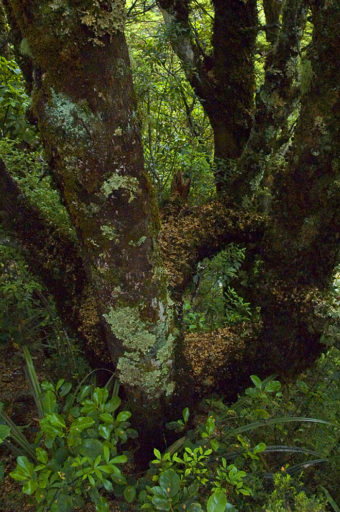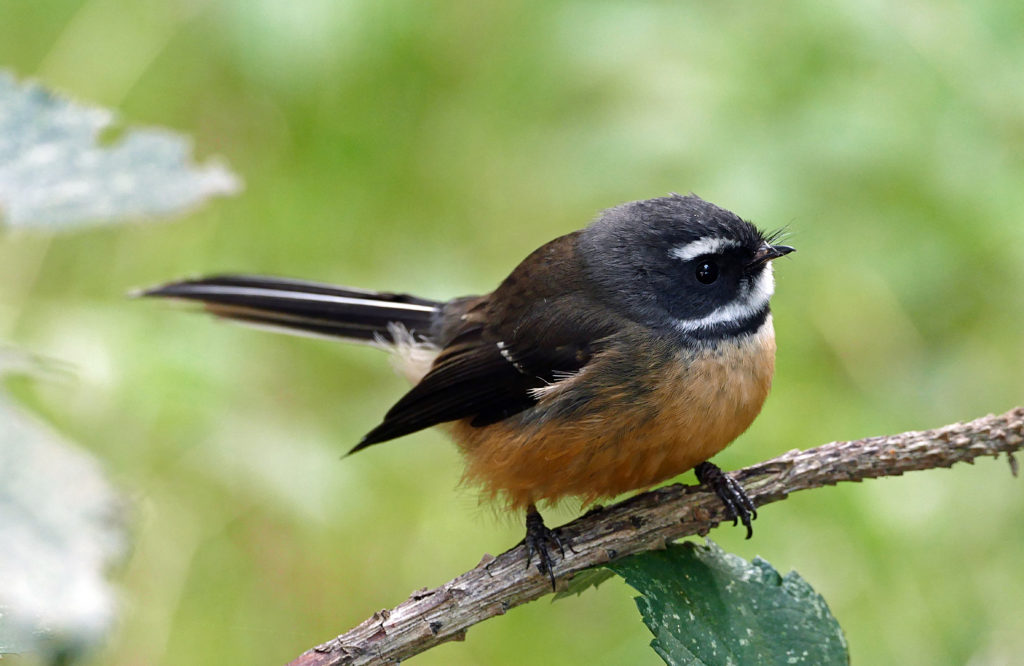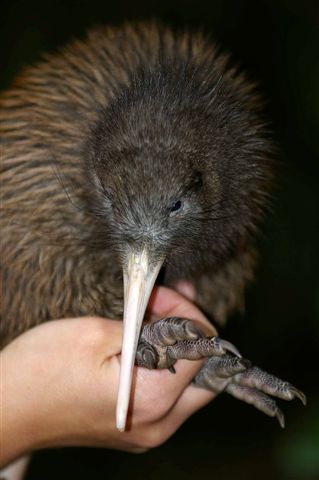A 22-year study in Tongariro Forest has followed 142 radio-tagged North Island brown kiwi through 4 landscape-scale aerial 1080 operations, covering an area of 20,000 hectares. Not only did all 142 kiwi survive the 1080 drops, but the long-term study reveals a swag of other interesting information on kiwi chick survival and fantail nesting success immediately after the operations and in the intervening 5 years until the next 1080 drop.

Researchers also investigated how quickly predator populations recovered, with a big difference in the rates of recovery for rat, possum and stoat numbers.
The study was carried out by Department of Conservation researchers, Hugh Robertson, Jerome Guillotel, Tony Lawson and Nicole Sutton and has just been published in Notornis the research journal of Birds New Zealand.
The 4 aerial broadcast 1080 operations targeted brushtail possums and rats, with a secondary kill of stoats which fed on poisoned rats.
“Unmanaged mainland populations of the North Island brown kiwi are declining by around 2–3% per year, mainly due to adult kiwi being killed by domestic dog and ferret, and the predation of chicks by stoat. At unmanaged sites, high levels of stoat predation can reduce kiwi recruitment to 5% compared with the approximately 20% recruitment that is typically required to maintain a stable population. Although adult mortality is the key factor driving kiwi population change, the control of stoat is often the most practical and achievable way of reversing population declines.”
Controlling stoats by trapping is difficult, however. Some individuals can be extremely trap-shy.
“Landscape-scale control by trapping stoat has had mixed results in New Zealand, working well at some sites and poorly at others. Furthermore, although poison bait station operations, which result in secondary poisoning of stoat, have been shown to benefit kiwi recruitment, the geographical scale of such protection is limited in the same way as trapping operations are constrained. By contrast, landscape-scale (10,000–50,000 ha) or super-landscape-scale (50,000–250,000 ha) aerial 1080 operations have the potential to protect significant kiwi populations through secondary poisoning of resident stoat.”
Aerial 1080 operations not only kill most possums and rats. The stoats get poisoned too. Population numbers eventually recover – but at very different rates.
“It is known that aerial 1080 operations kill nearly all resident possum and rat, the numbers of which can return to near their initial densities in 10–15 years for possum, but in as little as 4–5 months or as long as over 2 years for ship rat. It has also been shown that in New Zealand forests, nearly all resident stoat are killed by secondary poisoning following bait station or aerial 1080 operations and so landscape-scale 1080 operations in forests have the potential to suppress stoat numbers long enough to allow a cohort of kiwi chicks to reach around 1 kg at 6–8 months old, at which stage they are generally safe from stoat predation.”

This study looked at the effect of such landscape-scale 1080 operations on the population dynamics of the easternmost population of brown kiwi in the Whanganui-Taranaki area, at a site that is being managed as the Tongariro Kiwi Sanctuary. The nesting success of New Zealand fantail through two 1080 operations at Tongariro Forest and in the years between these operations was also monitored.
“Fantail is a common and widely-distributed endemic forest passerine, but ship rat are important predators of their nests. There was a period of 5–6 years between each successive 1080 operation. Therefore, the survival of brown kiwi chicks and success of fantail nests were aggregated according to the number of years since the last 1080 operation.”
‘Smart’ technology meant that transmitters not only showed the location of kiwi, but when they started incubating an egg.
From 1992 to 2005, adult male kiwi in Tongariro Forest were caught and fitted with a Sirtrack™ or Kiwitrack™ radio-transmitter. Since 2005, kiwi have been fitted with ‘smart’ transmitters that use the activity patterns of males to provide information in their coded signals on the time when incubation commenced (Egg Timer®) and chicks had hatched (Chick Timer®).
No such ‘smart’ technology for the fantails though.
“Fantail nests were found by following focal birds as they built their nests, changed over incubation spells with their partner or fed nestlings. Wherever possible, the nest contents were determined using a mirror on an extendable pole. Nests were visited every 2–4 days until the nesting attempt failed or the chicks fledged c. 30 days after the first egg was laid.”

“The tracking rates of rats (presumably mainly ship rat), mouse, and stoat were each averaged across three 1080 cycles starting in 2001, 2006, and 2011. There was a very sudden and dramatic decline in the tracking rates of all 3 mammalian pest species immediately after each 1080 operation, regardless of the sowing rate, which varied from 2 to 4 kg/ha, with rat tracking decreasing from approximately 70% beforehand (60 months after the last 1080 operation) to <1%, mouse tracking decreasing from 15% to 1–3% and stoat tracking decreasing from 20% to 0%.”
Aerial 1080 operations were carried out roughly every 5 years. Mouse populations were the first to recover after each 1080 drop and mice enjoyed a brief heyday initially, before rats reappeared on the scene.
“Mouse tracking rates recovered faster than rat tracking rates, reaching a peak of 50% c. 1 year after the 1080 operation before falling away to <20% after 2 years, following which they remained well below 10% for most of the remaining 3 years of the cycle. Rat tracking rates generally built up slowly over the first 9 months after each operation, and then increased rapidly between 9 and 20 months to reach a plateau at c. 70–80% that was maintained, with some variation between 55% and 84%, for the next 40 months. Stoat tracking rates took much longer to recover to pre-poison levels, with a slow linear increase until the following 1080 operation, but with summer peaks.”
So how did the kiwi and fare during and after predators were killed by 1080?
“None of the 85 radio-tagged adults and 57 radiotagged subadults that were exposed to aerially-sown 1080 were accidentally killed by 1080 poison over the 4 different operations. The only death that was recorded in the 2 months after these operations was a subadult that died from transmitter entanglement in vegetation 52 days after the poison drop.”
Some kiwi did, however, die of ‘natural’ and predation events during the 22-year study.

“Of the 163 subadults that were radio-tagged in Tongariro Forest between 1996 and 2014, 47 died. The cause of death could not be determined for 20 of these birds, but 15 of the remaining 27 birds were killed by predators: 5 by ferret, 2 by stoat, 3 by either stoat or ferret, 3 by pig, 1 by a dog and 1 by an unidentified predator. In addition, 3 subadults drowned, 2 were hit by vehicles, 2 had entangled transmitters, and 1 each died of disease, bill deformity, hypothermia, burrow collapse, and by falling into a hole.”
Kiwi and fantail chicks were clear benefactors of the reduction in predators – at least initially.
“Both kiwi chick survival to 6 months old and New Zealand fantail nesting success were significantly higher in the first 2 breeding seasons following the use of 1080 poison than in subsequent years of the 5-year cycle.”
Kiwi chicks were also radio tagged and their progress followed and, for those that didn’t survive, cause of death was investigated if possible.
“A total of 207 brown kiwi chicks in Tongariro Forest were radio-tagged at <37 days old and monitored between 2 January 1996 and 30 June 2014. An additional 22 radio-tagged ONE (Operation Nest Egg) juveniles were released at 123–182 days old and included in the analyses from their time of release. Of the 99 chicks that died of known causes, 82 appeared to have been killed by cat or mustelid, including stoat (at least 42). Of the 18 chicks that died from causes other than predation, 10 died by misadventure (drowning, falling in holes, or being impaled on sharp sticks), 6 died as a result of hatching difficulties or being malformed, one died of hypothermia, and one injured its leg so badly in a fall that it had to be taken for successful veterinary treatment (but was considered to have died for the purposes of this analysis).”
Both weather events (snow, hail, strong winds) and rat predation affected nesting success of fantails. The weather can’t be controlled, but controlling rats did benefit the fantails.
“We followed a total of 293 nesting attempts of fantail in Tongariro Forest during 10 of the 11 breeding seasons between 2002 and 2012. The nesting success of fantail in Tongariro Forest was highly variable between years during the 11-year study and was significantly related to the time since aerial application of 1080. Our research has shown that fantail also received a significant benefit in the first 2 years of the 1080 cycle, whereas they would receive no benefit if kiwi were managed ex-situ. Ironically, the increased rate of “clean takes” of fantail nest contents in the latter years of the study, which was associated with long-tailed cuckoo predation, may have resulted from long-tailed cuckoo enjoying increased breeding success as a result of their host, the whitehead, also having better nesting success in years when rat and stoat were scarce following each 1080 operation.”
So there are benefits for both brown kiwi and fantail in aerial 1080 predator control operations for an initial year or two. But is a 5-year interval between operations too long?
“We observed several episodes of ferret killing multiple adult kiwi, particularly in the last half of the 1080 cycle. Population modelling showed that a 5-year 1080 operation cycle resulted in population gains for 2 years, followed by declines in the remaining 3 years that largely negated these benefits. Our data thus support the shift to a 3-year 1080 operation cycle which will more likely result in this kiwi population growing at close to the 2% per year target set by the 2018–2028 Kiwi Recovery Plan.”

